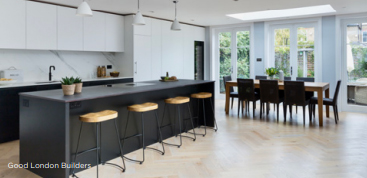Menu
Your project may be your biggest investment of recent years, so understanding costs and controlling risks is paramount. For successful and happy projects, expectations and available funds have to match

Finally getting the green light to build your dream home is a tantalising prospect; there will be no need to move or to envy other people’s homes. Your future build will have everything you ever wanted all under one roof. However, there are two key aspects you should consider when contemplating a project budget.
Whether you are project managing, contracting the works yourself or employing an architect and/or project manager, the same rule applies: you must keep a tight handle on the money.
The first key consideration regarding managing a project budget is the objective.
The best advice is fourfold:
• List the order of your aims, and ask your architect /project manager about how capital costs might be determined as this will inform the core of a budget
• Consider ways in which you, or your advisers, could formulate a spreadsheet. It need not be complicated but you should understand its components, their relevance and interaction
• Understand the tripartite diagram of costtime-quality. We all want to achieve high quality at low cost in least time
• It is generally recognised that the realisation of most building projects has to settle for two of these factors as your key objectives, and recognise that your priority aims will influence the third.
The second key consideration is control, and the description of the project and detailed information are a t the heart of controlling objectives and risks. To manage the budget and obtain maximum value you need to understand the process of building and where the money goes by commissioning appropriate documentation – the right drawings, specifications, schedules and contracts.
There are three primary components to the costs of any project and these are the building costs, the fees for any professionals you employ and VAT.
BUILDING COST
This is what you pay someone to do the work, and it should be under the terms of a proper building contract. Within your budget allocations there might however be items that are client sourced and supplied direct into the works, such as kitchen fittings, sanitary ware, ironmongery and electrical items
• The connection or alteration of services can be unexpectedly costly, so to be avoided whenever possible
• Allow for the cost of alternative accommodation if the nature of alterations and works inhibits staying in your home
• Contingencies – allow for the unforeseen during the execution of the works; that’s life, and it’s best to allow for things costing a mite more and taking a bit longer
FEES
Seek the best and most creative advice to maximise value
• The scope of architect/consultant services/project manager fees required to realise your project will be dependent on your own initiatives and capability to contribute to the process
• Determine and plan for the fees of the primary consultants, usually an architect, a structural engineer (whose input may be required for Building Regulation submissions) and project manager
• Allow for other fees such as surveys and measured surveys; statutory fees such as planning applications and building control inspection; and insurances and mortgages
• This component of project costs is dependent on the nature and scope of the building works, but commonly quantity surveyor cost plans apply a percentage factor of between 12.5 -17.5%.
VAT
• Allow for VAT as most reputable builders and services suppliers are not likely to be exempt
• The cost of works is likely to be discussed exclusive of VAT, as this is charged through your builder’s invoices and added to the architect/contract administrator’s valuations and certificates
• Consultant fees and costs are likely to be quoted ex-VAT too; when assessing the components of your overall project budget check VAT status in statutory and other fees.
Estimating costs is not a finite exercise, but online information and your builder or architect can help with basic ballpark building cost estimation using devices such as ‘build cost calculators’ and cost per unit area data.
Another guide to how much space can Source: Architect Your Home be created, altered or renovated is to work backwards from established available funding less the above associated costs divided by unit cost indicators.
Be conscious of limitations in these ballpark estimating methods as the variables of your personal brief and a particular existing context may have considerable influence on cost.
Here is where more detailed pricing techniques come in to establish and control building costs. For example, with specifications and Schedule of Works, it is sometimes possible to execute works based on just drawings, but it’s best if the drawings are complemented by specifications that describe the works in a scheduled format to test cost and seek best value.
In a similar vein, priced schedules are useful for the valuation of periodic payments, and in architect-administered contracts they provide the basis for cost control through interim and final certification.
If the budget is running away with you and you need to find savings or more time, remember that simplicity and good design will lead to a stylish and elegant finish.
Source: Architect Your Home